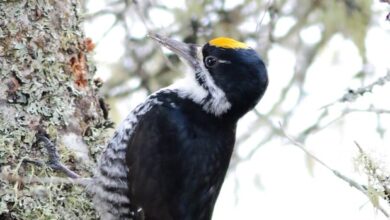From roundabout gardens to park meadows, how cities across Canada are encouraging pollinators
The transformation of a tiny patch of land at the center of a small roundabout on Glen Drive and 10th Ave. in Vancouver is a testament to the dedication and passion of Katie Berlinguette. Living in an apartment without a patio or yard, she longed for a space to cultivate plants and connect with nature. When faced with a long waitlist for community gardens, she discovered the Green Streets Program, which allowed her to adopt the overgrown roundabout near her apartment.
Initially, the roundabout was dominated by a towering rosebush, but with Berlinguette’s care and attention, it has been transformed into a vibrant pollinator garden. Native plants such as red-flowering currant and lupine now flourish alongside edible plants and herbs. A solar-powered fountain adds a touch of tranquility to the space, creating an oasis in the midst of the bustling city.
Berlinguette’s journey of revitalizing the roundabout has been chronicled on TikTok, inspiring others to find creative ways to garden in urban settings. The positive feedback from passersby reaffirms the impact of small changes in urban spaces.
Pollinator biologist Kaushal Rathnayake emphasizes the importance of protecting pollinators like bees, butterflies, and moths, highlighting their crucial role in maintaining healthy ecosystems. By creating pollinator-friendly habitats, individuals can contribute to the well-being of these essential insects.
Jens Ulrich, a PhD candidate at the University of British Columbia, conducted a study demonstrating the significant impact of small changes in urban green spaces on pollinator diversity. By introducing pollinator meadows in city parks, Ulrich and his team observed a notable increase in the number and variety of pollinators visiting these areas.
The success of the project has led the City of Vancouver to expand the initiative, converting a portion of its vast lawn spaces into beneficial pollinator habitats. The environmental benefits of these meadows, including improved soil health and increased biodiversity, underscore the importance of incorporating pollinator-friendly practices in urban planning.
Rathnayake advocates for the creation of a network of pollinator gardens and meadows to support urban pollinators. By educating the public and promoting biodiversity in both municipal and individual spaces, he believes that every community can play a role in conservation efforts.
As cities like Fredericton lead by example in promoting pollinator-friendly initiatives, Rathnayake emphasizes the importance of small, dedicated patches of pollinator gardens in yards and public spaces. By making simple changes and choosing the right plants, individuals can make a significant impact on pollinator populations.
In conclusion, the collaborative efforts of individuals like Berlinguette, researchers like Ulrich, and municipalities across Canada are paving the way for a more pollinator-friendly urban landscape. By recognizing the importance of pollinators and taking action to support their habitats, we can create a greener, healthier future for both wildlife and humans alike.




